Rabo de Toro: Spain meets Staffordshire in a rich Andalusian oxtail tapas dish
Winter is traditionally the time for slow-cooked stews, and oxtail with its rich flavour and soft, silky texture teased out by long cooking, is understandably a contender for this sort of comfort food.
But for me, oxtail evokes thoughts of warmer climates; specifically the southern Spanish cities of Seville, Córdoba and Ronda. Those are the places where I’ve eaten the best oxtail, in the form of the intensely flavoured tapas dish Rabo de Toro, or bull’s tail. Its garlicky sauce is rich and thick, usually incorporating red or white wine, sherry or brandy. You’ll almost always get a few potatoes alongside too – not exactly chips, not exactly roast potatoes – but deliciously soaking up a little of the meaty sauce.
It’s this version of oxtail, and how to get those potatoes tasting so good by using some of its fat, that I want to share with you today. I’ll also tell you where to source great Staffordshire beef for the oxtail.
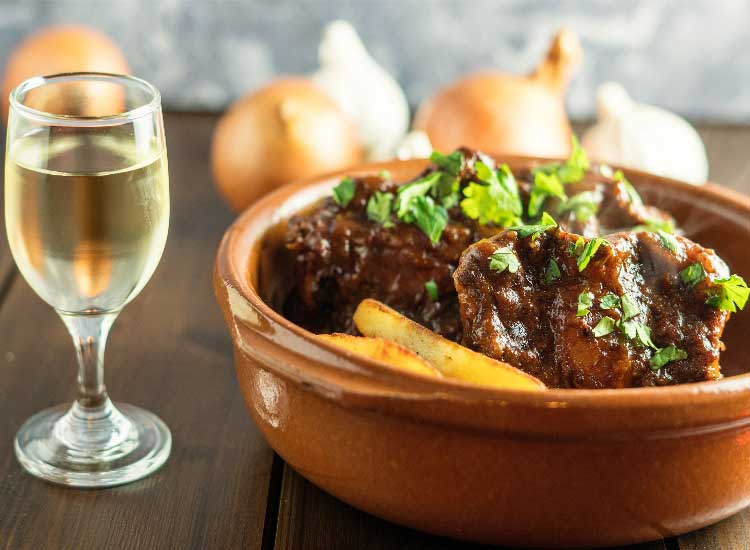
Jump to Recipe
the meat
Rabo de toro was originally developed so as not to waste any part of the bull killed in the bullfighting ring – hence the dish being more common in southern Spain, which is the home of bullfighting. But rest assured you need have no ethical qualms about the source of oxtail in this recipe, as I bought it from the unimpeachable Denstone Hall Farm Shop, a family-run affair near the Derbyshire border.
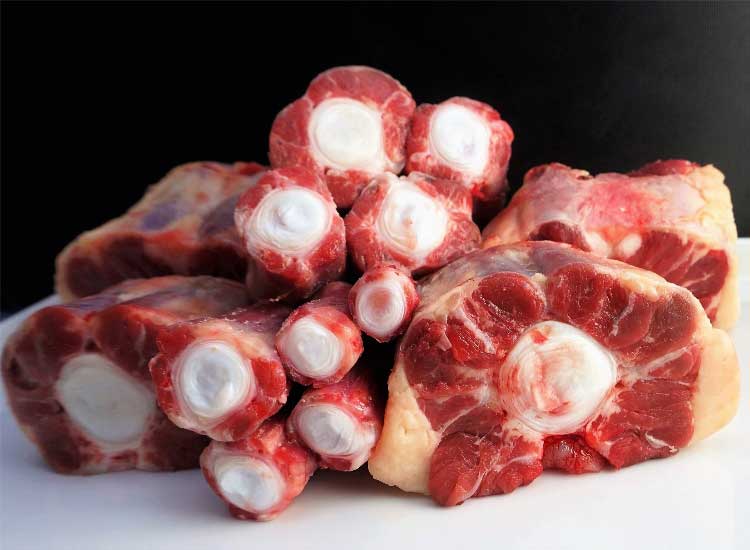
Denstone Hall is a great supplier of high quality, local produce including beef from the cattle on their own farm. The 28-day hung beef is not only sold from their excellent butchery counter, but also features in their homemade items such pies and lasagne available from their deli and packed chiller cabinets. You’ll find it in numerous guises on their café menu too, such as in burgers, steak pies, sandwiches and the like.
read my post about Denstone Hall Farm Shop & Café here
Oxtail not being so easy to come by these days, I phoned the butchery counter a few days in advance and they were happy to reserve one for me to collect. If you’re going to follow this recipe, don’t worry about the weight of meat to buy. Just get a whole oxtail, which will most likely weigh between one and one-and-a-half kilos, and use all of it. The butcher will chop it into pieces for you.
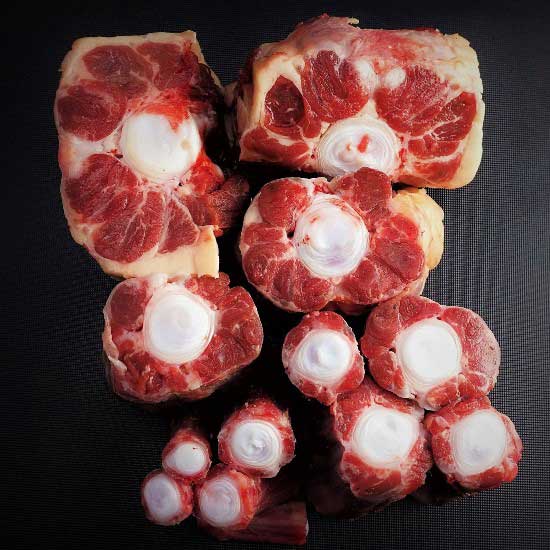
why rabo de toro & not oxtail stew?
Flavoursome as it is, there’s not an awful lot of meat on an oxtail. Consequently, the traditional British oxtail stew can feel a bit of a let down. It’s saddest examples are little more than a bowl of stock (albeit tasty stock) with, sitting in it, boiled vegetables and large bones with a little meat clinging to them.
That was my experience anyway when, as a child, we’d occasionally have homemade oxtail stew. My memory is one of struggling to scrape bits of meat off the boiling hot bones, chasing them around the bowl with a spoon.
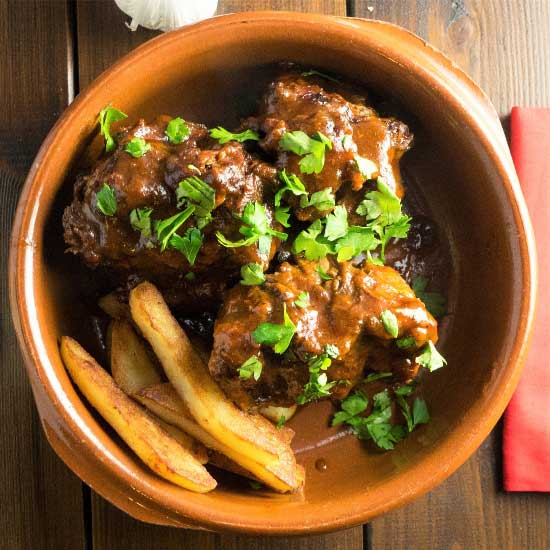
Imagine how much happier you’d be to have an attractive, terracotta tapas dish placed in front of you with just a few pieces of delicious-smelling Rabo de Toro, cloaked in a shiny, intensely-flavoured, reduced sauce.
I think it’s acceptable to eat this sort of dish with your fingers, so long as you don’t mind getting a bit messy. For me, that’s the best way to eat oxtail, accompanied by lots of napkins and helped along by judicious finger-licking.
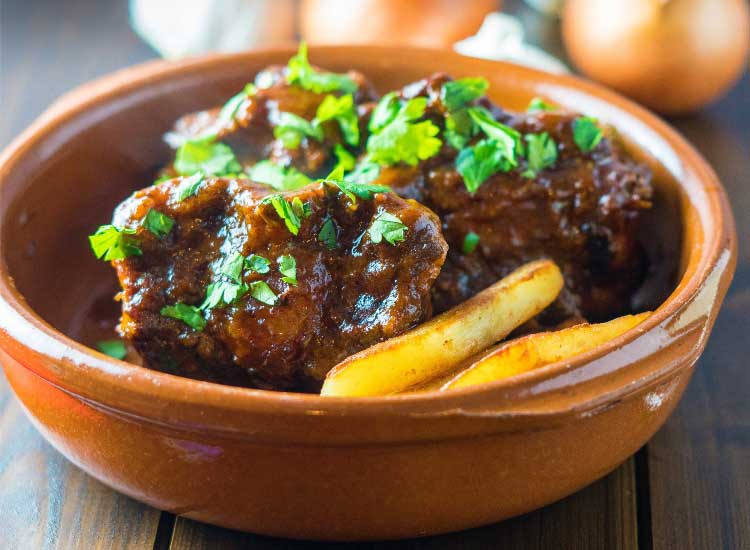
a word about potatoes and beef fat
I hope I’ve convinced you that you really do need to make this Rabo de Toro. But before you get going you first need to take my advice about the accompanying potatoes.
You could serve Rabo de Toro with chips or roast potatoes, but in the spirit of the Spanish who wouldn’t dream of wasting any part of the animal, I recommend you sauté potatoes in some of the oxtail fat. Potatoes cooked this way also happen to taste very good – which is why every decent fish and chip shop in the land used to cook their chips in beef fat.
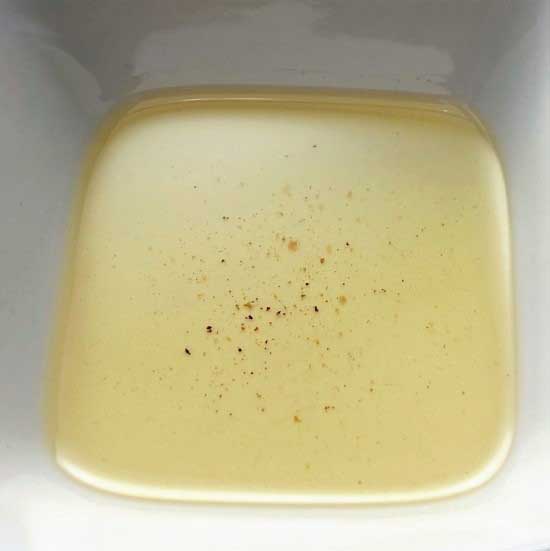
I’m telling you at this point, because you need to cut off the pieces of fat from the largest pieces of oxtail before you start the recipe proper.
If you scroll back up to the images of the raw oxtail, you’ll see that the largest pieces have little ‘ears’ of fat and it’s these you should remove before cooking. It’s simple to render the fat in a small, heavy frying pan while you get on with the rest of the dish: Jump to the recipe for Potatoes Sautéed in Beef Fat to see how to do this.
I must confess that, afterwards, I eat the browned remains (they taste like the fat you get on the outside of a good joint of roasted beef), but I accept that’s not for everyone.
casserole or slow-cooker? the Instant Pot is even better
In order to break down the tough fibres in the meat and to release the collagen and gelatine which will give the dish its unctuous texture, the oxtail needs to be cooked for a long time – anything from 3 to 5 hours. You can do this in a lidded casserole in a low oven or in slow cooker if you have one.
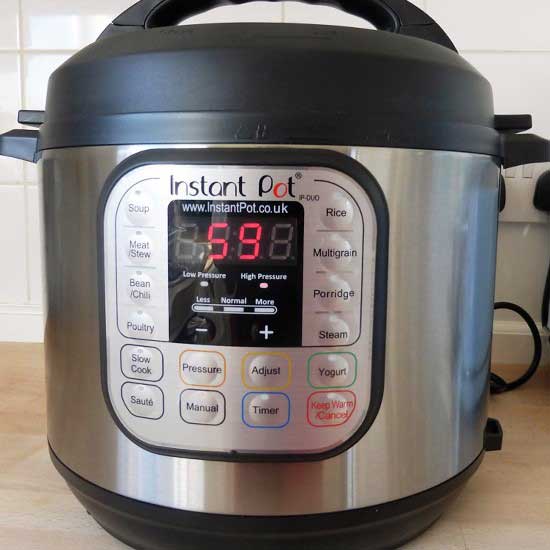
My preference, however, is for an electric pressure cooker, specifically the Instant Pot. Not only does the Instant Pot cut the cooking time down to just an hour or so, but all the liquid and flavour is locked in, meaning you don’t have to worry about it boiling dry and you’ll still end up with a flavour-packed sauce. You can also use the Instant Pot as a slow cooker, although I never have as those who’ve used both seem to agree that the pressure cooker gives much better results in terms of flavour.
In the detailed recipe, I’ve given instructions for both the Instant Pot and for cooking in the oven. If you choose to use a slow cooker then please follow the manufacturer’s instructions.
browning & flavouring
It’s important that the first step, browning the pieces of oxtail in olive oil, isn’t rushed. It’s important to make sure they’re nicely coloured all over as this will enhance the flavour of the sauce as well as the meat. Don’t crowd the pot with too many pieces at once either as the steam created will inhibit the browning process.

After the usual stewing vegetables (onion, carrot, celery, leek and garlic) are softened in the resulting meaty juices and also starting to colour, sherry and brandy (Spanish, of course) are bubbled in the pot until they’re reduced almost to nothing. You could use red or white wine instead, although I find red wine overwhelms the dish a little.
The browned oxtail is then returned to the pot along with seasonings (including smoked paprika, bay leaf and thyme), chopped tomatoes and a little beef stock. If you use beef stock cubes, try to find a low salt one as it gives you more control over the saltiness of your dish which is particularly important if you want to subsequently reduce the sauce.
refining the sauce
When the meat is cooked you could serve the ‘stew’ as it is, complete with the diced vegetables in the sauce. But the point of this dish is that it’s so much better to refine the sauce so that it’s smooth and glossy and clings beautifully to the oxtail pieces. To do this, remove the oxtail (keeping it warm in the meantime) and strain everything that’s left through a sieve and into a jug or bowl.
Using a combination of stirring and gentle pushing, you then squeeze out more of the precious sauce. Be careful though not to actually force the soft vegetables through the sieve as you just want them to give up any juices they’re hanging on to; if they get mushed through the sieve you’ll end up with thick vegetable soup instead of an attractive, glistening sauce. And I will be annoyed.
finishing the dish
At this point you could reduce the sauce a little if you’d like, by transferring it to a wide saucepan (to quicken evaporation) and bubbling vigorously for a few minutes. I taste for seasoning after this point and usually find it needs more salt.
You could also cool the sauce so as to remove any fat which rises to the top. However, if you follow my advice (and you will, won’t you?) and cut off much of the visible fat before you begin in order to make the accompanying potatoes, you’ll probably find almost no fat has risen to the top anyway so you could dispense with this stage.
I like to add the still warm pieces of oxtail to the sauce and simmer it a little which melds the flavours together and ensures the meat is nicely cloaked in its shiny sauce.
All that’s left to do then is divide the meat between dishes, sprinkle with some bright, chopped parsley and snuggle a few Potatoes Sautéed in Beef Fat around the meat.
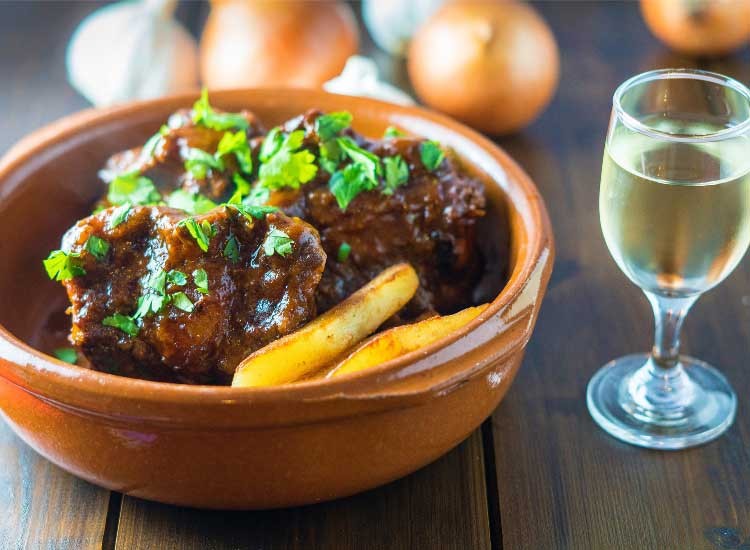
Serve with a glass of cold, dry sherry either on its own or with a selection of tapas dishes such as garlic fried prawns, chorizo cooked in cider, Serrano ham, Manchego cheese, olives and good bread.

Rabo de Toro: Spanish Oxtail
Instructions are given for making this dish in the Instant Pot or in a casserole dish in the oven. If you're using a slow cooker, please follow your manufacturer's instructions.
Ingredients
- 1 oxtail jointed by your butcher
- 1 tbsp flour
- salt
- freshly ground black pepper
- 1-2 tsp smoked paprika
- 2 tbsp olive oil
- 200 g onion (approx 1 large) diced
- 200 g carrot (approx 2 medium) diced
- 2 sticks celery diced
- 1 medium leek diced
- 6-8 cloves garlic skinned & thinly sliced
- 150 ml dry sherry
- 100 ml brandy Spanish if possible
- 1 tsp dried thyme
- 1 bay leaf
- 1 beef stock cube dissolved in 100ml hot water
- 400 g tin chopped tomatoes
- chopped parsley to serve
Instructions
If you're going to make the Potatoes Sautéed in Beef Fat:
-
Before starting the Rabo de Toro recipe, cut off most of the fat from the outside of the bigger oxtail slices and set aside. Follow the recipe for Potatoes Sauteed in Beef Fat.
For the rabo de toro:
-
Season the flour with a little salt, pepper and 1/2 tsp of the smoked paprika.
-
If using an Instant Pot (IP):
Put the olive oil in the IP and press the Saute button. When the oil is hot, lightly coat each oxtail piece in the seasoned flour and brown well, all over, in the oil. Do this in batches, setting aside the browned pieces on a plate as you go.
If cooking in the oven:
Preheat oven to 170C/325F/Gas 3
Heat the olive oil in a large casserole (it will need a lid later) over a moderate heat. Coat each oxtail piece in the seasoned flour and brown them in batches, following the above instructions for the Instant Pot.
-
Add the onion, carrot, celery, leek and garlic to the IP or casserole. Season lightly with salt and pepper. Stir around to coat in the oil, scraping up any browned bits from the bottom of the pot. Cook until softened and starting to brown (15-20min).
-
Stir in the sherry and brandy, bring to the boil and allow to bubble until almost all of the liquid has evaporated (3-5min).
-
Add the thyme, bay leaf, the remaining 1.5 tsp of smoked paprika, the beef stock, tomatoes and the browned oxtail. Stir to combine and add a little water if the oxtail isn't almost all underneath the liquid.
-
If using an Instant Pot (IP):
Press the Keep warm/Cancel button, put the lid on, ensuring the lever is pointing at Sealing rather than Venting. Press the Manual button and use the +/- keys to set the time at 60 minutes.
After the time is up, turn off the IP and leave for the pressure to release naturally. Switch to Venting, then carefully remove the lid. Test the meat to check that it is soft and almost falling off the bone. If it isn't, put the lid back on, switch on, press Manual and use the +/- keys to cook a further 15 minutes. Repeat until the meat is cooked to your liking.
If cooking in the oven:
Put the lid on the casserole dish before placing it in the oven. If there isn't a tight seal, place a sheet of foil over the casserole before putting the lid on. Cook for a minimum of 3 hours, checking now and then and adding more water or stock if it looks dry. If after 3 hours the meat isn't soft and almost falling off the bone, continue to cook, checking every 30 minutes until it's done to your liking.
-
When the meat is cooked, remove the pieces of oxtail to a dish and keep warm.
-
Strain the liquid through a sieve into a jug or bowl, stirring and pressing down on the vegetables to squeeze out as much sauce as possible without pushing the veg through the sieve.
-
If you wish to reduce the sauce, place in a clean, wide saucepan and bubble for a few minutes until to your liking.
-
Add salt and pepper to taste before pouring the sauce over the cooked oxtail.
Serve with Potatoes Sautéed in Beef Fat

Potatoes Sautéed in Beef Fat
Ingredients
- fat cut from the outside of an oxtail
- 2 medium potatoes peeled & thickly sliced
- salt
- freshly ground black pepper
Instructions
To render the beef fat:
-
Place the pieces of fat into a small, heavy frying pan then switch on the heat to low-medium. Leave for the fat to render out, checking now and then that it isn't burning.
-
When no more more is being released (approx 20-30min), remove the remaining pieces of fat and pour the liquid fat into a suitable container for later use.
For the potatoes:
-
Place the sliced potatoes in a saucepan, add salt plus cold water to cover.
-
Bring to a boil, turn down to a simmer and cook until the potatoes are almost, but not quite done (8-10 min).
-
Strain the potatoes and leave to cool a little. You can also refrigerate at this point and saute the potatoes later.
-
Cut the cooled potatoes into chips (or cubes if you prefer).
-
Heat the rendered beef fat in a frying pan over a moderate-high heat then add the potatoes (in batches if necessary). Brown the potatoes on all sides, stirring around until they're cooked through and crispy on the outside. Drain on kitchen towel and keep warm while you cook the remaining potatoes.
-
Season with salt and pepper before serving with Rabo de Toro.
RELATED RECIPES

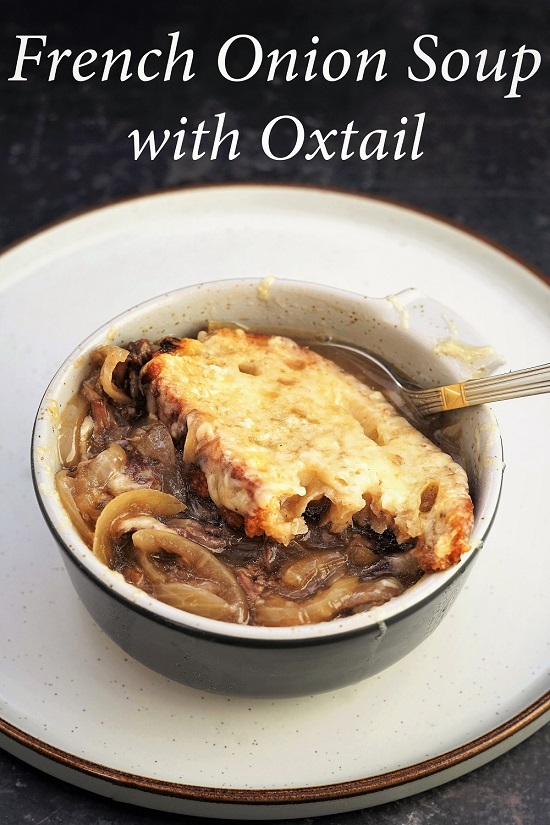
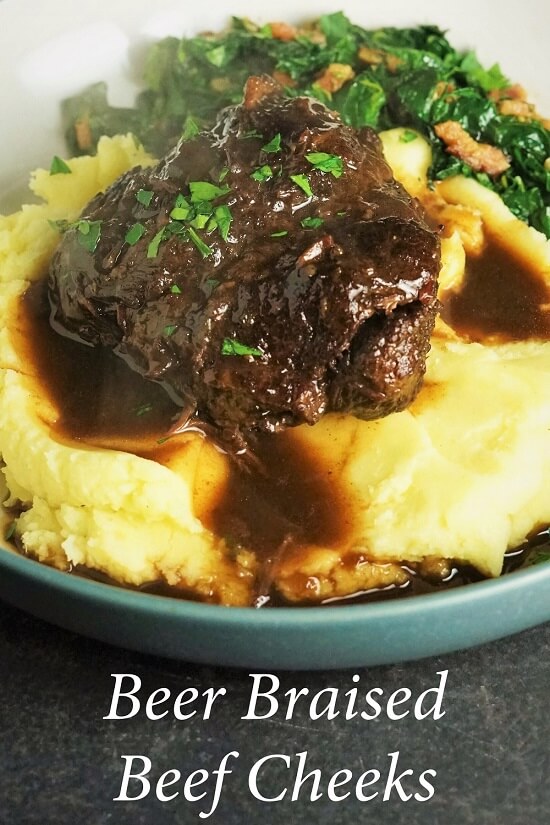
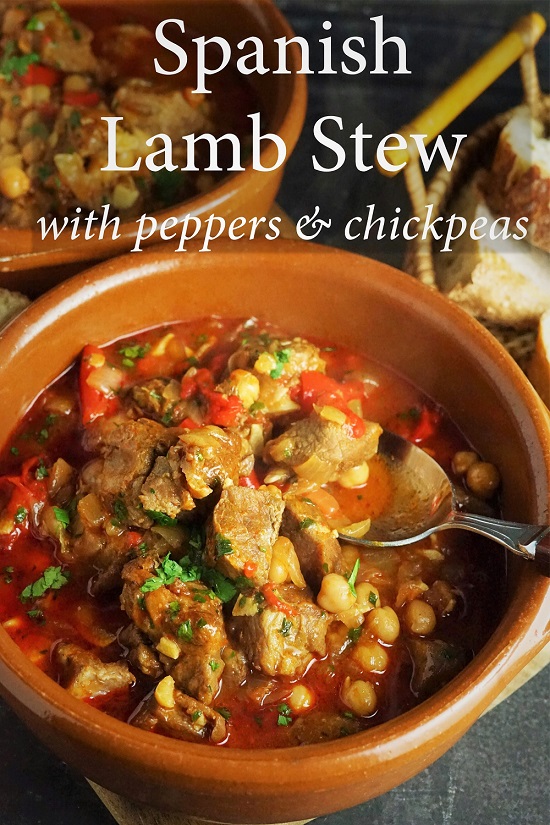

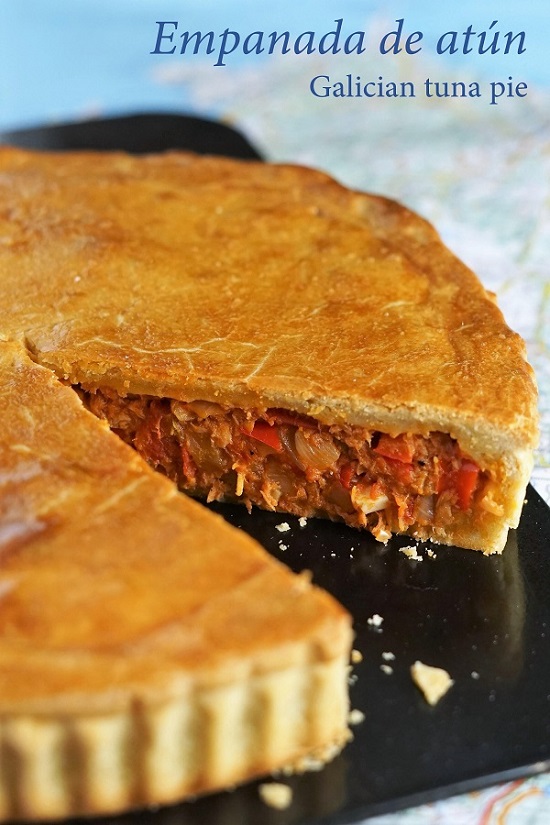
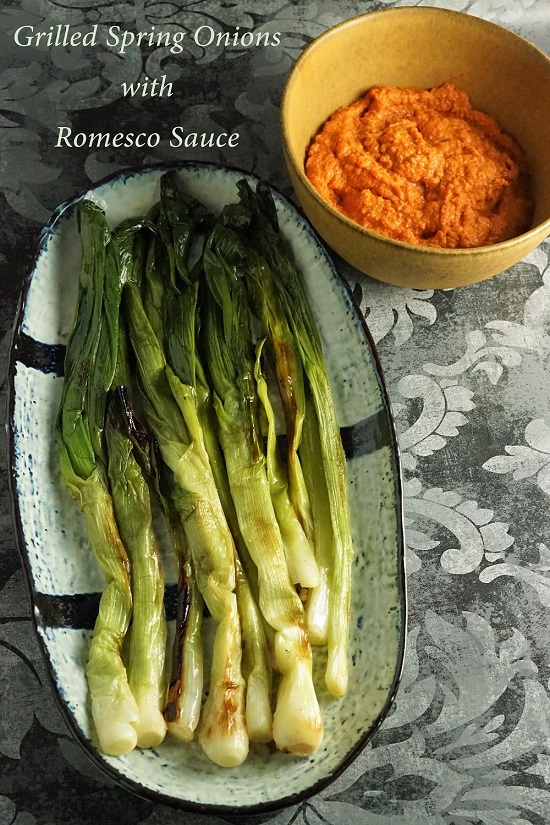
I had Rabo de Toro in San Sebastien this year, but it was placed on toasted brioche, I used this recipe to cook the oxtail (slow cooker) when ready pressed the meat then placed in toasted brioche. The gravy was placed in little ramekin dishes which allowed me to dunk the sandwich in the gravy. Absolutely superb. Oh and potatoes with beef fat, completely right.
Thank you for your lovely feedback. I absolutely love the sound of how you served it: wonderful!
I’ve cooked this a few times over the past couple of years having discovered it in bars in Seville – after reading the American comment above I felt, in support of the author that its important to point out that this is entirely in line with the authentic dish we sampled in Spain. Totally love this recipe!
Thank you for your kind comments, Rose.
So glad you loved this recipe!
Made this yesterday and was surprised by the amount of residual fat that was created from stewing the tailbones. My version did use Sherry and Red wine but no Brandy. No aversion, Just because we didn’t have any.
While the sauce is good, very tasty. It was not what I was expecting or looking for. Theres a restaurant in Tampa that makes this dish as an appetizer and we love the dish. Their sauce is a rich brown and silken textured masterpiece in flavor. The sauce this produced I’d say was more red, with a predominately tomato sweetness that overpowered everything else. It was almost as if we had added white sugar, it was that sweet. The red, I assume was the result of the tomatoes and smoked paprika. But the flavor we had hoped for was not Made by this recipe.
So again, it was a tasty version. But if you are not a huge fan of tomato sauce, (I am not, except for pasta) try a different spin. Or maybe nix the tomatoes in favor of more concentrated beef stock? That might change this in the right direction.
Oh definitely agree with the author on reducing to a sauce as opposed to serving as a stew. After five hours at 350 degrees the veggies had lost any resemblance to stew anyway. But they tasted good. Also, agree with author that the salt content is severely lacking. We added salt and cracked pepper while reducing to compensate. The result was better. But we think the meat would have benefited from more salt while cooking.
I wonder if you’ve commented on the correct post?
You’ve included red wine, which isn’t in this recipe, so of course the result will not be the same. Nor do I suggest you cook the dish for 5 hours.
Here in Britain, tinned tomatoes are quite acidic ands, as there’s no added sugar in the recipe, it seems impossible for you to have found the result sweet.
As you can see from the images, the recipe certainly does not produce a red sauce.
The recipe also doesn’t specify the amount of salt and your comment ‘agree with author that the salt content is severely lacking’ is baffling.
As I say, your comments don’t appear to be relevant to this particular recipe.
I’ve been wanting to try this for a while and when the temperature dropped again after the May heatwave decided to. My local butcher prepacks his oxtail and trims it so I couldn’t use the fat. I compromised though with some good quality beef dripping for the potatoes. The recipe was simple enough to follow. I couldn’t though bring myself to use sherry as I’m too mean to cook with the decent stuff we had so used the end of a bottle of red wine. It seemed to work well and I also missed the brandy out. I cooked the meat the day before eating so the flavours permeated through it. There was a good depth of flavour. We have an Aga so cooking started in the top oven and then was slowly finished in the bottom. My wife is a big oxtail fan and she really enjoyed it. A bottle of Spanish red was the perfect accompaniment. I’d certainly do it again. Maybe next time go old school with some mash. Not quite the tapas spirit but I’m sure that will be forgiven.
Many thanks for the detailed feedback, John – it’s always lovely to hear what people think of my recipes. So glad you and your wife enjoyed it, and that you gave the fat-cooked potatoes a go too (although I’ll certainly forgive you if you fancy it with mash next time!)
I sometimes make rabo de toro with red wine, like you, instead of sherry and it’s easily as good, just different.
p.s so sorry for the late response, your message went into a spam black hole: annoying!